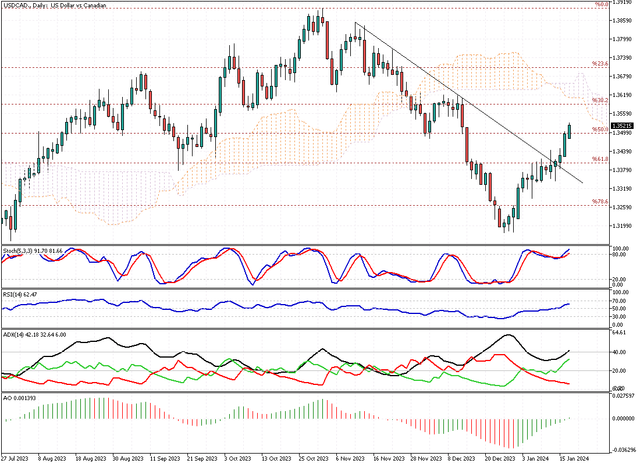SOLIDECN
Senior member
- Messages
- 3,041
- Likes
- 0
Canadian Dollar Weakens Amid Inflation Surge

Solid ECN – In January, the Canadian dollar experienced a notable depreciation, crossing the 1.345 mark against the US dollar. This movement marked its weakest position in over a month, primarily influenced by the strengthening of the US dollar. This shift in currency value comes amidst anticipations and speculations regarding policy decisions from the Bank of Canada (BoC) and the Federal Reserve in the United States.
Investors are displaying a sense of uncertainty, particularly about the timing of the Federal Reserve's expected reduction in interest rates. This uncertainty is coupled with the recent developments in Canada's domestic economic indicators, especially regarding inflation. Contrary to some expectations of monetary policy easing by the BoC, current inflation data has added complexity to the situation. In December, Canada's headline inflation rate rose to 3.4%, up from 3.1% in the previous month. This increase marks the first Consumer Price Index (CPI) acceleration in four months, indicating persistent inflationary pressures.
Moreover, the trimmed-mean core gauge, a measure closely monitored for its reflection of underlying inflation trends, unexpectedly surged to a four-month high of 3.7%. This data is particularly significant as it contrasts with the BoC's earlier statements. The BoC had indicated a desire to see a substantial slowing in its preferred core inflation measures before considering any rate cuts. This recent uptick in inflation measures suggests that the central bank might not be able to ease monetary policy as quickly as some market participants had hoped.
Investors are displaying a sense of uncertainty, particularly about the timing of the Federal Reserve's expected reduction in interest rates. This uncertainty is coupled with the recent developments in Canada's domestic economic indicators, especially regarding inflation. Contrary to some expectations of monetary policy easing by the BoC, current inflation data has added complexity to the situation. In December, Canada's headline inflation rate rose to 3.4%, up from 3.1% in the previous month. This increase marks the first Consumer Price Index (CPI) acceleration in four months, indicating persistent inflationary pressures.
Moreover, the trimmed-mean core gauge, a measure closely monitored for its reflection of underlying inflation trends, unexpectedly surged to a four-month high of 3.7%. This data is particularly significant as it contrasts with the BoC's earlier statements. The BoC had indicated a desire to see a substantial slowing in its preferred core inflation measures before considering any rate cuts. This recent uptick in inflation measures suggests that the central bank might not be able to ease monetary policy as quickly as some market participants had hoped.














